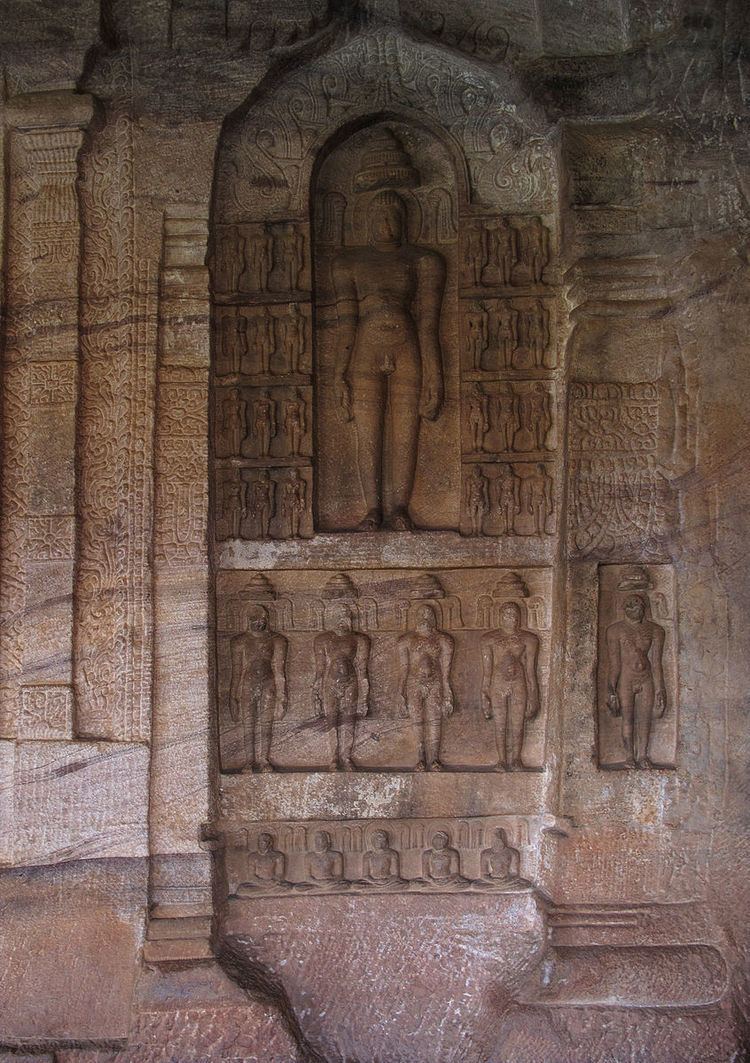 | ||
Digambara (/dɪˈɡʌmbərə/; "sky-clad") is one of the two major schools of Jainism, the other being Śvētāmbara (white-clad). The word Digambara (Sanskrit) is a combination of two words: dig (directions) and ambara (sky), referring to those whose garments are of the element that fills the four quarters of space. Digambara monks do not wear any clothes. The monks carry picchi, a broom made up of fallen peacock feathers (for clearing the place before walking or sitting), kamandalu (a water container made of wood), and shastra (scripture). One of the most important scholar-monks of Digambara tradition was Kundakunda. He authored Prakrit texts such as the Samayasāra and the Pravacanasāra. Other prominent Acharyas of this tradition were, Virasena (author of a commentary on the Dhavala), Samantabhadra and Siddhasena Divakara. The Satkhandagama and Kasayapahuda have major significance in the Digambara tradition.
Contents
Monasticism
The word Digambara is a combination of two Sanskrit words: dik (दिक्) (directions) and ambara ( अम्बर ) (clothes), referring to those whose garments are of the element that fills the four quarters of space. Digambara monks do not wear any clothes as it is considered to be parigraha (possession), which ultimately leads to attachment. A Digambara monk has 28 mūla guņas (primary attributes). These are: five mahāvratas (supreme vows); five samitis (regulations); pañcendriya nirodha (five-fold control of the senses); Şadāvaśyakas (six essential duties); and seven niyamas (rules or restrictions).
The monks carry picchi, a broom made up of fallen peacock feathers for removing small insects without causing them injury, Kamandalu (the gourd for carrying pure, sterilized water) and shastra (scripture). The head of all monastics is called Āchārya, while the saintly preceptor of saints is the upādhyāya. The Āchārya has 36 primary attributes (mūla guņa) in addition to the 28 mentioned above. The monks perform kayotsarga daily, in a rigid and immobile posture, with the arms held stiffly down, knees straight, and toes directed forward. Female monastics in Digambara tradition are known as aryikas.
Lineage
According to Digambara texts, after liberation of the Lord Mahavira, three Anubaddha Kevalīs attained Kevalajñāna (omniscience) sequentially – Gautama Gaņadhara, Acharya Sudharma, and Jambusvami in next 62 years. During the next hundred years, five Āchāryas had complete knowledge of the scriptures, as such, called Śruta Kevalīs, the last of them being Āchārya Bhadrabahu. Spiritual lineage of heads of monastic orders is known as Pattavali.
The Digambara tradition was divided into two main orders:
The Bhattarakas of Shravanabelagola and Mudbidri belong to Deshiya Gana and the Bhattaraka of Humbaj belongs to the Balatkara Gana.
Historicity
Relics found from Harrapan excavations like seals depicting Kayotsarga posture, idols in Padmasana and a nude bust of red limestone give insight about the antiquity of the Digambara tradition. The presence of gymnosophists (naked philosophers) in Greek records as early as the fourth century BC, supports the claim of the Digambaras that they have preserved the ancient Śramaṇa practice.
Worship
The Digambara Jains worship completely nude idols of tirthankaras (omniscient beings) and siddha (liberated souls). The tirthankara is represented either seated in yoga posture or standing in the Kayotsarga posture.
The truly "sky-clad" (digambara) Jaina statue expresses the perfect isolation of the one who has stripped off every bond. His is an absolute "abiding in itself," a strange but perfect aloofness, a nudity of chilling majesty, in its stony simplicity, rigid contours, and abstraction.
Scriptures
The Digambara sect of Jainism rejects the authority of the texts accepted by the other major sect, the Svetambaras.
According to the Digambaras, Āchārya Dharasena guided two Āchāryas, Pushpadanta and Bhutabali, to put the teachings of Mahavira in written form, 683 years after the nirvana of Mahavira. The two Āchāryas wrote Ṣaṭkhaṅḍāgama on palm leaves which is considered to be among the oldest known Digambara texts. Āchārya Bhutabali was the last ascetic who had partial knowledge of the original Jain Agamas. Later on, some learned Āchāryas started to restore, compile and put into written words the teachings of Lord Mahavira, that were the subject matter of Agamas.
Digambaras group the texts into four literary categories called anuyoga (exposition). The prathmanuyoga (first exposition) contains the universal history, the karananuyoga (calculation exposition) contains works on cosmology and the charananuyoga (behaviour exposition) includes texts about proper behaviour for monks and Sravakas.
Differences with Śvētāmbara sect
According to Digambara texts, after attaining Kevala Jnana (omniscience), arihant (omniscient beings) are free from human needs like hunger, thirst, and sleep. According to the Digambara tradition, a soul can attain moksha (liberation) only from the male body with complete nudity being a necessity.
Sub-sects
Digambaras are divided into various sub-sects viz. Terapanthi, Bispanthi, Taranpanthi (or Samayiapanthi), Gumanapanthi and Totapanthi.
Terapanthi
The Terapanthis worship the idols with ashta-dravya just like the Bispanthis, but replace flowers and fruits with dry substitutes. The ashta-dravya jal (water), chandan (sandal), akshata (sacred rice), pushp (yellow rice), deep (yellow dry coconut), dhup (kapoor or cloves) and phal (almonds). Terapanthi is a reformist sect of Digambara Jainism that distinguished itself from the Bispanthi sect. It formed out of strong opposition to the religious domination of traditional religious leaders called bhattarakas in the 17th century. They oppose the worship of various minor gods and goddesses. Some Terapanthi practices, like not using flowers in worship, gradually spread throughout most of North Indian Jainism as well. Terapanthis occur in large numbers in Rajasthan, Uttar Pradesh and Madhya Pradesh.
Bispanthi
Besides tirthankaras, Bispanthi also worship Yaksha and Yakshini like Bhairava and Kshetrapala. Their religious practices include aarti and offerings of flowers, fruits and prasad. Bhattarakas are their dharma-gurus and they are concentrated in Rajasthan and Gujarat.
